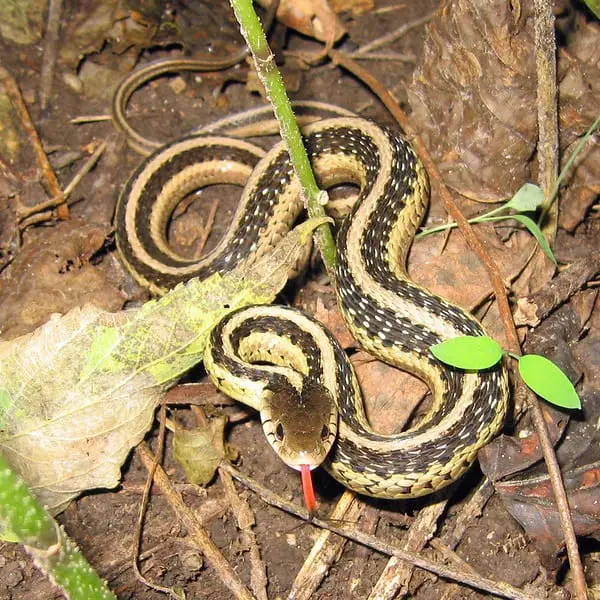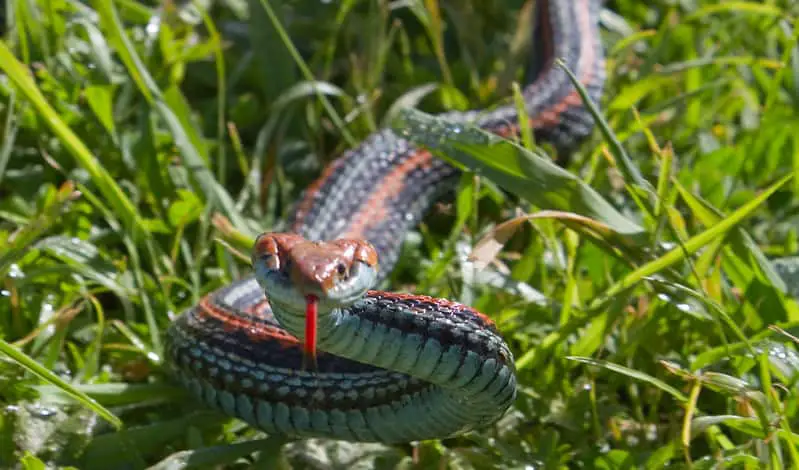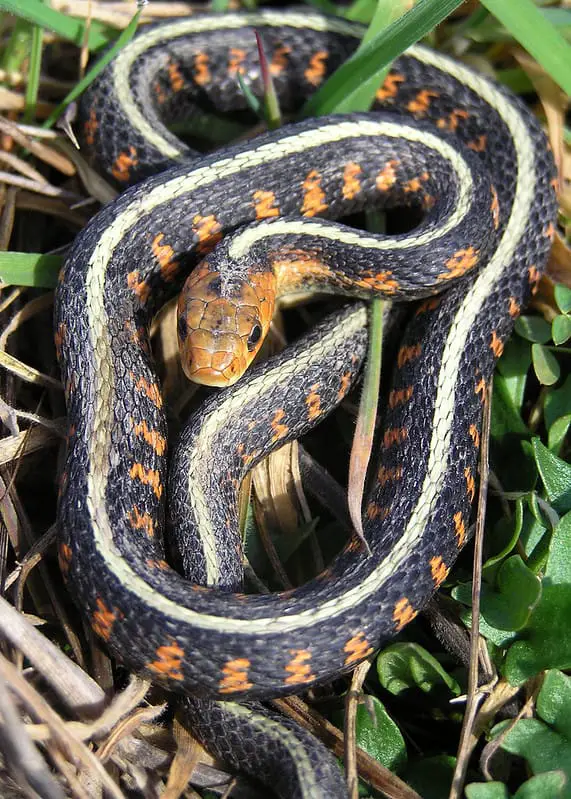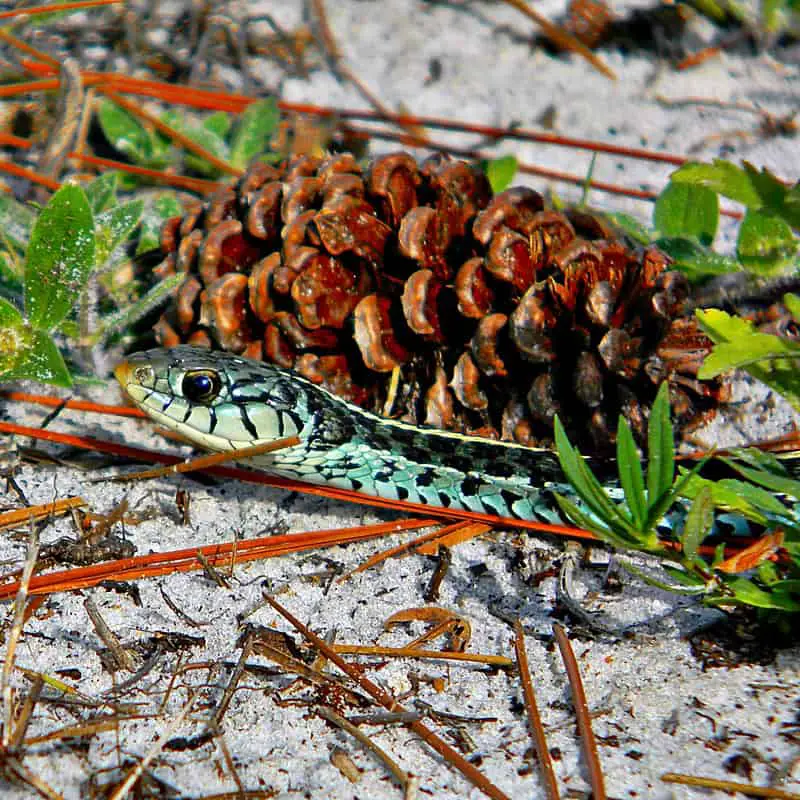The common garter snake is the best-known and most widespread species among the garter snakes. It can be found throughout the United States, Canada and Mexico. It lives in forests, meadows and swamps, but also parks and gardens. Proximity to waters is always a prerequisite. The predominantly day-active common garter snake spends most of its time sunbathing or hunting. Its a peaceful, but lively snake. The main characteristic of the common garter snake is a bright stripe along the upper body of the snake that can take on various colors.

Description
The 13 subspecies of the common garter snake differ among other things by a variety of color variations. Common to all of them are the mostly brightly set back and side stripes, to which the genus owes the name garter snake. They have a round head with large eyes. Their scales are strongly keeled, which gives them a dull, rough appearance. Garter snakes with brown/black body coloration and yellow stripes are often confused with the closely related plains garter snake that occurs throughout the Central United States.
Size
Females usually reach a length of around 40 inches (100 cm), sometimes up to 48 inches (120 cm). Males are considerably smaller and reach a length of up to 25 inches (60 cm).

Coloration and Pattern
As mentioned, all subspecies of the common garter snake have several longitudinal stripes along the entire body. They have one clearly defined bright stripe along the top of the body. Two more stripes run long the side of the body. These stripes are mostly less well-defined and often have a checkered or blotched pattern. The lower body side is usually brighter colored than the rest of the body. Garter snakes have a remarkably long tail compared to other North American snake species.

Hunting Behavior
The common garter snake has a broad food spectrum. Fish, slugs, worms, amphibians, mice, rats and even small birds are all part of their diet. A special feature of this snake species is that it is one of the few, if not the only natural enemy of the rough-skinned yellow-bellied newt (Taricha granulosa). In the course of evolution it has become immune to the highly toxic defense substance of this salamander. After eating the salamander, it enters a dormant stage and slows down its metabolism, in order to compensate for the effect of the toxin. It is thought to be the only organism that can survive the ingesstion of this toxin.
Bite
Garter snakes have a mildly toxic saliva that can cause a slight burning or itching sensation for humans or pets. Overall, a bite is not medically significant or dangerous. Through the toxines that garter snakes absorb from eating yellow-bellied newts, their body becomes somewhat poisonous as well. This serves the snake as a defense mechanism against larger predators.

Habitat
Although garter snakes are considered part of the “water snakes” group, they live mostly on land. They prefer humid habitats such as streams, rivers, lakes, swamps, but can also be found in cultivated regions or even in forests and mountainous areas. Garter snakes are very good swimmers and are often found swimming through rivers or swamps.
Common Garter Snake range in the USA
In North America the common garter snake is the most common reptile species. Its habitat extends throughout the United States and south to Mexico. It is the only snake species that can be found in Alaska and at least one of its subspecies occurs in every U.S. State including Hawaii. Namely, these are: Alaska, Arizona, Alabama, Arkansas, California, Colorado, Connecticut, Delaware, Florida, Georgia, Hawaii, Idaho, Illinois, Indiana, Iowa, Kansas, Kentucky, Louisiana, Maine, Maryland, Massachusetts, Michigan, Minnesota, Mississippi, Missouri, Montana, Nebraska, Nevada, New Hampshire, New Jersey, New Mexico, New York, North Carolina, North Dakota, Ohio, Oklahoma, Oregon, Pennsylvania, Rhode Island, South Carolina, South Dakota, Tennessee, Texas, Utah, Vermont, Virginia, Washington, West Virginia, Wisconsin and Wyoming.
Scientific classification of Thamnophis sirtalis
- Kingdom: Animalia
- Phylum: Chordata
- Class: Reptilia
- Order: Squamata
- Suborder: Serpentes
- Family: Colubridae
- Genus: Thamnophis
- Species: Thamnophis sirtalis
Subspecies of Thamnophis sirtalis and their range
- Thamnophis sirtalis dorsalis – New Mexico garter snake (New Mexico)
- Thamnophis sirtalis pallidulus – maritime garter snake (New England, Canada)
- Thamnophis sirtalis sirtalis – eastern garter snake (Througout the U.S. and Canada)
- Thamnophis sirtalis tetrataenia – San Francisco garter snake (endangered species) – San Francisco Bay Area
- Thamnophis sirtalis parietalis – red-sided garter snake (Western Canada)
- Thamnophis sirtalis fitchi – valley garter snake (California, Nevada)
- Thamnophis sirtalis concinnus – red-spotted garter snake (Pacific Coast – Washington, Oregon, California)
- Thamnophis sirtalis pickeringii – Puget Sound garter snake (Pacific Northwest)
- Thamnophis sirtalis semifasciatus – Chicago garter snake (Illinois, Wisconsin, Indiana)
- Thamnophis sirtalis infernalis – California red-sided garter snake (California)
- Thamnophis sirtalis annectens – Texas garter snake (Kansas, Texas)
- Thamnophis sirtalis similis – blue-striped garter snake (Florida)
- Thamnophis sirtalis lowei